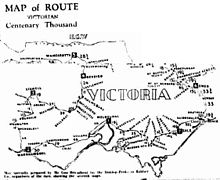Centenary 1000
| Centenary 1000 | |
|---|---|
| General | |
| Held | 20–27 October 1934 |
| Country | Australia |
| Region | Victoria |
| Type | Seven-day stage race |
| Distance | 1,102 miles (1,773 km) |
| Winners | |
| Handicap | F Stubenrauch, Vic |
| Championship | Harry Cruise, Vic |
The Centenary 1000 cycling race was a one-week road bicycle race over seven stages covering 1,102 miles (1,773 km). The race was run in 1934 as part of the celebrations of the Centenary of Victoria. The race was originally conceived along the lines of the Dunlop Grand Prix, won by Hubert Opperman then aged 23, by 1h 20' and the concept for the race was covering 1,000 miles (1,600 km) with prizes exceeding £1,000, including a climb over Mount Hotham.
The race attracted the top riders from Australia and New Zealand as well as Frenchmen Paul Chocque and Fernand Mithouard and Italian Nino Borsari. The Australian riders included Opperman, Richard "Fatty" Lamb, Ossie Nicholson, Hefty Stuart, Ern Milliken, Horrie Marshall and Ken Ross. Also competing were riders who would come to prominence in the following years, including Alan Angus, Dean Toseland, Clinton Beasley and Bill Moritz. The only notable Australian absentee was Frankie Thomas who had been suspended for 18 months. Nicholson had been suspended for 12 months for interfering with a rider making a record attempt but was able to have the suspension lifted in time to ride.. Efforts were made to also have Thomas’ suspension lifted, but to no avail. The New Zealand riders were Harry Watson, who had finished 2nd in the 1927 Dunlop Grand Prix, L W Hill and Alby Ralston.
The major races in Australia at the time were conducted as handicap races, including the Warrnambool to Melbourne and Goulburn to Sydney. There was a push for the race to be run on “continental lines", that is as a scratch race. The organisers however expressed concern that only a small number of riders could win in a scratch race and that the Sydney to Melbourne championship race had been ridden at a low speed of 15.7 miles per hour (25.3 km/h), "was a contest of tactics, not of speed and endurance" and that there was "loafing by the whole field of riders over many miles" of the final stage. The compromise was a graded handicap, with 30 riders graded on scratch and similar numbers in each of the other grades. By way of comparison the handicaps for the 1933 Warrnambool to Melbourne had 21 handicaps of between 10 and 70 minutes. The championship title was decided on aggregate time with bonus time deductions on each stage of 1' 30" for the fastest, 1' 00" for the second fastest and 0' 30" for the third fastest. The handicap title was to be determined by a complex point system, with 130 points for first through to 30 for 100th for most stages and the fifth stage to Omeo had an extra 20 points. The grade handicaps varied slightly from stage to stage as follows:
...
Wikipedia

